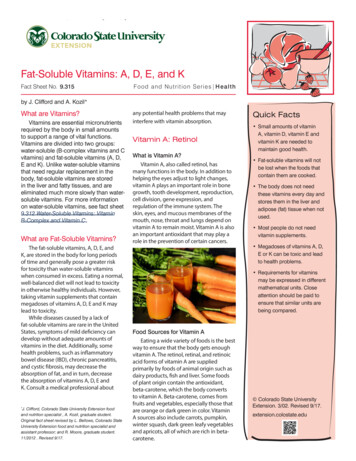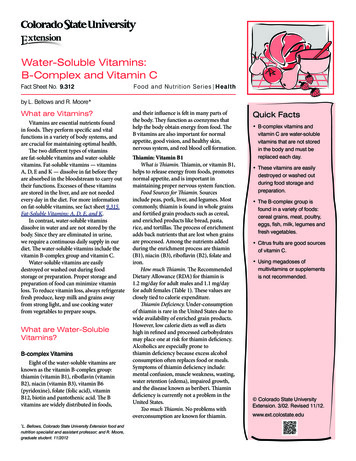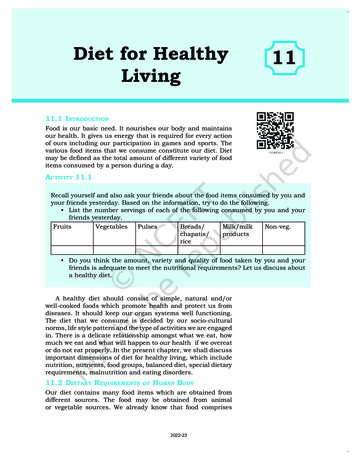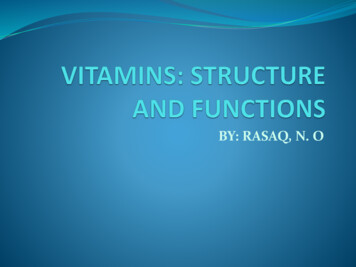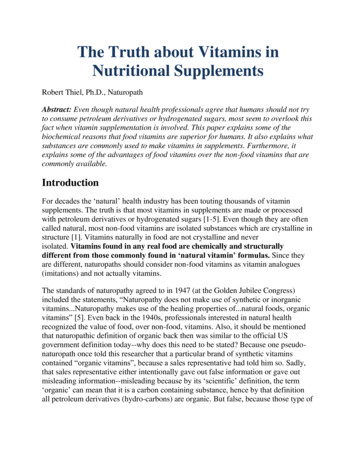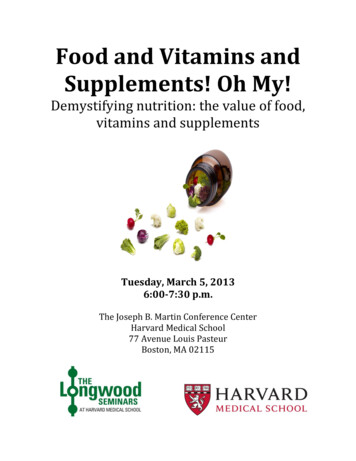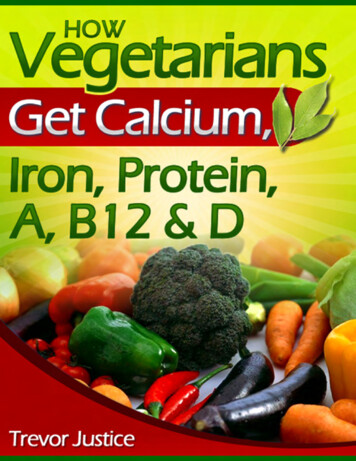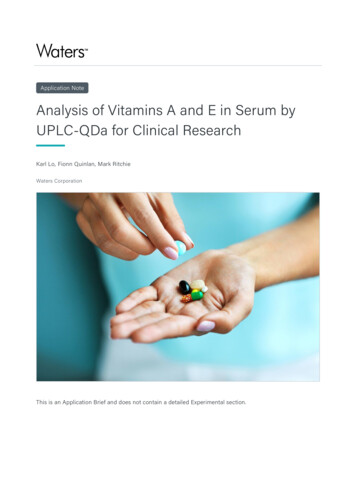
Transcription
Application NoteAnalysis of Vitamins A and E in Serum byUPLC-QDa for Clinical ResearchKarl Lo, Fionn Quinlan, Mark RitchieWaters CorporationThis is an Application Brief and does not contain a detailed Experimental section.
AbstractHere we describe a clinical research method for the simultaneous analysis of vitamins A and E in serum bysingle quadrupole mass detector, the ACQUITY QDa. The extraction method is a modification of a previousLC-MS/MS method, using HLB Prime for sample preparation. The combination of a chromatographicmethod that uses an ACQUITY UPLC HSS PFP Column and an ACQUITY QDa testing under SIR modeprovides an accurate and sensitive method for the analysis of the vitamins A and E in serum. The injectioncycle is just 5 minutes and the sensitivities could achieve 100 ppb and 1 ppm for vitamins A and E in theserum, respectively.Benefits An accurate and sensitive method for the analysis of the vitamins A and E in serum using a singlequadrupole mass detector, the ACQUITY QDa and an ACQUITY UPLC H-Class System Simple sample preparation method compared to LLEIntroductionHistorically, the majority of vitamins A and E analysis is performed by HPLC with UV detection. Even whenthe analysis of vitamin A and E involves LC-MS/MS, the extraction methods used such as liquid-liquidextraction (LLE) suffer from very long extraction times, with high solvent consumption and lengthy analysistime. Previously, we have shown a clinical research method on LC-MS/MS that requires just 100 μl samplevolume and provides a shortened analysis time.1 The removal of phospholipid by Oasis HLB PRiME (SPE) is akey factor in this improvement of performance. In this technical brief, we will demonstrate how LC-MS couldprovide an accurate and sensitive analysis of vitamin A and E from the serum.ExperimentalIsotopically labelled internal standards were added to the 100 μL serum and then a protein precipitationprocedure was performed by the addition of ethanol. After centrifugation, the supernatant was diluted by
ethanol/water (5:3) to give a final ethanol/water ratio of 2:3. The resulting solution of 650 μL was applied toOasis HLB elution plates for sample clean up. The sample was cleaned with 20% ACN (aq) and then elutedin 100% ACN. The eluent was further diluted with water to 200 μL (Figure 1). Taking the advantage of usingHLB PRiME, no activation and evaporation step was required. The 20 μL resulting extract was injected to LCMS for the analysis.Figure 1. Chromatograms of 100 ppb of vitamin A and 1 ppm of vitamin E in serum.Using an ACQUITY UPLC H-Class PLUS System with an ACQUITY HSS PFP Column (1.8 μm, 2.1 x 50 mm,P/N:186005965 -100a-18--m-21-mm-x-50-.html ), a gradient elution of 65% mobile phase A (MP A) to100% MP A was run to achieve the separation. Detection was performed by ACQUITY QDa under ESIpositive and SIR mode for the corresponding protonated adducts. The injection cycle was 5 minutes.LC ConditionsLC system:ACQUITY UPLC H-Class ParameterVials:96-well collection plate containing 1 mL inserts(P/N: 186000855)
ColumnACQUITY UPLC HSS PFP Column 2.1 x 50 mm,1.8 µm (P/N: 186005965)Column temp.:40 CSample temp.:10 CInjection volume:20 µLFlow rate:0.40 mL/minMobile phase A:Water 2 mM NH4Ac 0.1% formic acidMobile phase B:MeOH 2 mM NH4Ac 0.1% formic acidGradientMS ConditionsMS system:ACQUITY QDaIonization mode:ESI
Acquisition modeSIRCapillary voltage:0.8 kVCone voltage:See channel detailsData ManagementLC-MS software:MassLynx v4.2Results and DiscussionFigure 2 shows the chromatograms of 100 ppb and 1 ppm of vitamin A and E in the stripped serum(MSG2000). The analytical sensitivity investigations demonstrate that quantitation at 100 ppb of vitamin Aand 1 ppm of vitamin E are achievable (%RSD 20, Bias 15%, S/N 10). The method was shown to be linearacross the range of 100 ppb to 2000 pp for vitamin A and 1 ppm to 20 ppm for vitamin E. Correlationcoefficients (r2) 0.993 achieved for both compounds across 10 separate occasions. Example of calibrationcurves are shown in Figure 2.
Figure 2. Examples of calibration curves of vitamins A and E.Precision was assessed by extracting and analysing 5 replicates from low to high concentrations in strippedserum over 5 days (n 25). Repeatability and total precision were 8% CV at all concentration levels testedfor vitamin A and E and they were summarised in Table 1. All calculated % recoveries were within 15% fortypical endogenous interferences tested when comparing test and control samples.Matrix factor results were within 15% between test samples from six individuals and control samplescompensated for using the internal standard (Table 2). Matrix suppression was observed for vitamin E(mean 0.653 and 0.730), but it was compensated by the internal standard (mean 0.977 and 0.939).
ConclusionWe explored the application of a UPLC-Single Quadrupole MS System, the ACQUITY UPLC-ACQUITY QDa,on a clinical research analysis of fat-soluble vitamins. The results show that the method is accurate andanalytically sensitive even in a complex matrix. The sample preparation is relatively simple compared to LLEand the run time is significant decreased compare to traditional HPLC-UV methods.References1. Simultaneous Analysis of Vitamin A and E in Serum by UPLC-MS/MS for Clinical Research. WatersCorporation, UK, 2019. Waters Application Note 720006642EN e-serum-uplc-ms-ms-clinical-research.html .Featured ProductsACQUITY UPLC H-Class PLUS System https://www.waters.com/10138533 ACQUITY QDa Mass Detector https://www.waters.com/134761404 MassLynx MS Software https://www.waters.com/513662
TargetLynx https://www.waters.com/513791 720007164, February 2021 2021 Waters Corporation. All Rights Reserved.
quadrupole mass detector, the ACQUITY QDa and an ACQUITY UPLC H-Class System Simple sample preparation method compared to LLE Introduction Historically, the majority of vitamins A and E analysis is performed by HPLC with UV detection. Even when the analysis of vitamin A and E involves LC-MS/MS, the extraction methods used such as liquid-liquid
